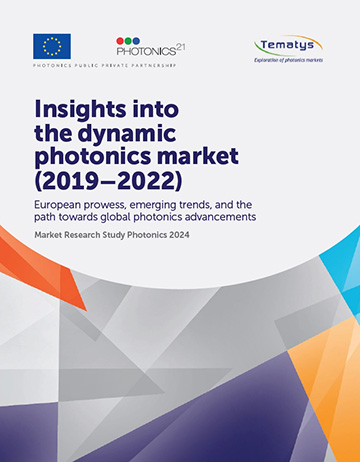
[Image: brichuas / iStock / Getty Images Plus]
Photonics21—the public-private partnership (PPP) that helps organize European Union–wide photonics funding and that advocates for the economic and social importance of photonics on the continent—held its annual general meeting on 14 and 15 May 2024, in Brussels, Belgium. One of high points of the meeting was the release of a recently commissioned research report that looked at the global photonics market’s performance during the early pandemic period.
The report emphasized the above-average growth of photonics worldwide—even amid a “deglobalizing” environment characterized by mounting trade frictions and geopolitical risks. Yet it also underscored some emerging challenges for European photonics. In particular, the report suggested, Europe will increasingly face hurdles tied to China’s growing dominance in important sectors, the emergence of industrial policy as a tool of statecraft in the United States, and Europe’s own historical difficulties in marshalling the capital investment necessary to scale up promising early-stage companies.
Indeed, the Photonics21 PPP meeting agenda itself evoked a European industry in a state of some flux as it adjusts to these new competitive and trade realities. For additional insight, OPN recently spoke with Optica Fellow Christoph Harder—a principal in the consulting firm Harder & Partner and president of the Swissphotonics Association—to get his impressions on the meeting and on where European photonics is headed.
From ETP to PPP
Photonics21 was born nearly two decades ago, in 2005, as one of 25 European Technology Platforms (ETPs) under the aegis of the European Commission. The ETPs were designed to bring together key stakeholders in the research and industry communities to serve, in a sense, as idea-generating machines to help forge a strategic agenda for important European technology segments.

Christoph Harder. [Image: Courtesy of C. Harder]
Harder suggests that Photonics21’s initial formation as an ETP was important both in drawing together the European photonics community in a “voluntary, informal and non-incorporated” body and in providing input to EC funding calls, beginning with those underlying the 7th Framework Programme in 2006. (The EU framework programs are seven-year vehicles for organizing the European Union’s research spending.) Photonics21 also advocated for photonics to be named a “Key Enabling Technology” by the EC in 2009, increasing the discipline’s potential leverage in the competition for funding.
An important next milestone for Photonics21 came in 2013, with the formation of a new contractual public-private partnership (cPPP) under the EU’s next framework program, Horizon 2020. The PPP involved the creation of a new Photonics21 Association separate from the original ETP, and including corporate members. It also committed the EU to a €700 million spend across the seven years of Horizon 2020, with industrial partners in the PPP expected to kick in four euros to every one EU euro—a total commitment of €2.8 billion.
Photonics21 successfully lobbied for a renewal of the PPP, with a new memorandum of understanding, in 2021, under the Horizon Europe framework program, which runs through 2027. The new PPP agreement envisioned a smaller EC investment of €340 million directly into photonics.
Harder says that, beyond specific funding levels, Photonics21 and the PPP have been important as a vehicle for networking and connections—a key factor in how the funding game is actually played. “Some people say that even if you don’t get any money, the connections in the [Photonics21] working groups” are important, he notes, allowing input in how funding calls are developed. Photonics21 also is a source of market research and reports, including a strategic research and innovation agenda that is “the roadmap” for European photonics priorities.
Market report: Photonics on a growth path
The release of one such market report was a highlight of the May 2024 Photonics21 annual meeting. The new study, Insights into the Dynamic Photonics Market (2019–2022), was compiled for Photonics21 by the France-based research firm Tematys. It was based on comprehensive analyses of corporate reports, business databases and company records for photonics-related firms, supplemented by an online survey.
A new Photonics21-commissioned report found that worldwide photonics industry revenues expanded at a compound annual growth rate (CAGR) of 6.8% between 2019 and 2022, and an inflation-adjusted CAGR of 4.3%, far outstripping inflation-adjusted global GDP growth of 2%.
Some of the study’s marquee findings were quite positive for the worldwide photonics industry, suggesting a fair amount of resilience amid the challenging climate of the early pandemic. Tematys found that worldwide photonics industry revenues expanded at a compound annual growth rate (CAGR) of 6.8% between 2019 and 2022, and an inflation-adjusted CAGR of 4.3%. Those numbers far outstripped inflation-adjusted global GDP growth of 2%. Tematys placed the total value of the worldwide photonics market at US$865 billion in 2022, and forecast growth to US$1.2 trillion in 2027.
The European share of that worldwide output, according to Tematys, amounted to €124.6 billion (around US$131 billion) in 2022, roughly 15% of the global photonics market and around 3% of Europe’s total manufacturing output. The photonics share came from more than 5,000 small and medium-sized enterprises (SMEs) across the continent. And while the CAGR for European photonics between 2019 and 2022, at 6.5%, slightly lagged the global average, it still far outpaced the 2% overall annual GDP growth in Europe over the same period.
Tougher global competition

[Image: Photonics21]
The Tematys report highlighted particular strength for Europe in niche sectors like Industry 4.0, defense and health care, and projected continued growth for the industry to around €175 billion in annual output by 2027. Harder believes the study clearly manifests the European industry’s overall growth and its strength in emerging and niche technologies.
Yet the study—and some of the buzz at the Photonics21 annual meeting—also pointed to a few future challenges for European photonics on the world stage. One relates to the rise of China as a worldwide player in photonic technologies. A startling observation in the Tematys study was that China’s global market share in photonics has expanded from 10% in 2005 to more than 26% in 2015 and 32% in 2022—which the report authors drily characterized as “a notable ascent.”
Indeed, the session introducing the market study at the Photonics21 meeting was preceded by a talk by Daniela Bartscher-Herold, a founding partner of EAC International Consulting, Munich, on China’s “political steering” of core segments of the photonics business. Harder told OPN that Bartscher-Herold offered “very detailed and competent insights” on photonics in China. “She said China has a ‘three-three rule’,” he recalls. “China grows three times faster than Europe, and has three times the market share.”
Harder points out that China’s current areas of strength—consumer lighting, photovoltaics, telecom, high-power lasers—were once strong in Europe. He suggested that China’s “government-driven effort” gives it an advantage once a business reaches a certain scale and begins to become a mass market. “You aren’t competing against the factory in China; you are competing against the Chinese government,” he says.
Of tariffs and chips acts
The Tematys market report argues that, while Europe has a “world-leading research capacity” for emerging technology areas, it has seen a “notable gap in capital investment” in photonics relative to the United States and Asia. That lack of capital follow-through, the study says, has made it difficult to scale up Europe’s innovation activities in photonics.
The Tematys market report argues that Europe has seen a “notable gap in capital investment” in photonics relative to the United States and Asia, which has made it difficult to scale up Europe’s innovation activities in photonics.
Tematys further notes the increasing appetite in some countries for “industrial policy,” embodied in the United States by a greater willingness to impose tariffs, and by legislation such as the Inflation Reduction Act and the CHIPS and Science Act—something that could heighten the pressure. On the chips front in particular, the EU has responded with its own initiatives, including the European Chips Act, unveiled in February 2022, and the Chips Joint Undertaking (Chips JU), a mechanism for funding and supporting cross-European projects to build advanced semiconductor manufacturing on the continent.
These efforts have potentially positive implications for companies and labs developing photonic integrated circuits. That interest was reflected in several sessions at the Photonics21 meeting, including a talk on photonics’ place in the European Chips Act and a workgroup session focusing on funding opportunities for photonics in the Chips JU.
Still, if these European initiatives hold clear opportunities for integrated photonics, Harder also points to some disadvantages. In a macro sense, he notes, there’s the issue of inefficiency and duplication as different countries or regions each strive for “sovereignty” in semiconductor production. “If every country is building its own TSMC-style chip fab, it looks great—but in the end it’s going to drive inflation and a lack of personnel.”
There’s also the danger that photonics could get lost as an independent enterprise within the much bigger sway of the electronics industry. “The politicians are now saying, ‘Photonics, electronics, it’s all the same—why don’t we just give you one budget?’” Harder observes. “And we have to say, no, we are SMEs, and electronics firms are €10 billion companies … We are like a mouse in a cage with an elephant.”
“Quo vadis photonics?”
The backdrop of global forces such as the increased competitive profile of China, the various chips acts and the rise of industrial policy, Harder notes, led to a certain amount of soul-searching at the Photonics21 meeting. Just what is photonics today, and where is it going? The mood was epitomized in the title of a panel discussion, “Quo Vadis Photonics?,” which focused on how photonics can carve out a role in the emerging chips ecosystem and strengthen its global competitiveness.

[Image: Photonics21]
The question of “what is photonics” is getting more difficult to answer, Harder suggests, partly because of changes in emphasis on the EU level. Early in the history of Photonics21, he says, it was “very much technology driven.” But more recently, EU politicians have structured funding around societal challenges such as aging, mobility and environment. This market-based, rather than technology-based, approach is now embodied as well in the Photonics21 workgroups, which today cover broad market areas such as digital infrastructure, manufacturing, health, climate and agriculture to align with EU priorities.
One downside of this approach, Harder says, is that “if you become market driven, then for any enabling technology, it becomes difficult because you ‘disappear’ in applications.” He believes that’s one reason that many academics are gravitating toward quantum technology, where markets are still largely unformed and where they can focus on basic, foundational research.
“And so there are some politicians,” Harder observes, “who say ‘Is there still a photonics?’ Because you have integrated circuits [now bundled] with electronics, and basic science within the quantum initiatives. What’s left?”
Looking ahead to 2027
Photonics21 will remain an important vehicle for answering that question, at least for the next several years. Harder stresses that the PPP has played a big role in bringing the European photonics community together, in facilitating networking and discussion, and in setting a continent-wide research agenda through market and strategic studies. “It has helped to integrate Europe,” he says.
The next big test for Photonics21 will presumably come in 2027, when the current PPP agreement comes to an end as the EU rolls into whatever framework program succeeds Horizon Europe. There’s a fair amount of uncertainty on what happens after that, Harder suggests, and he believes that re-engaging with the big European health care, industrial and telecom sectors will be important in keeping the project moving forward.
